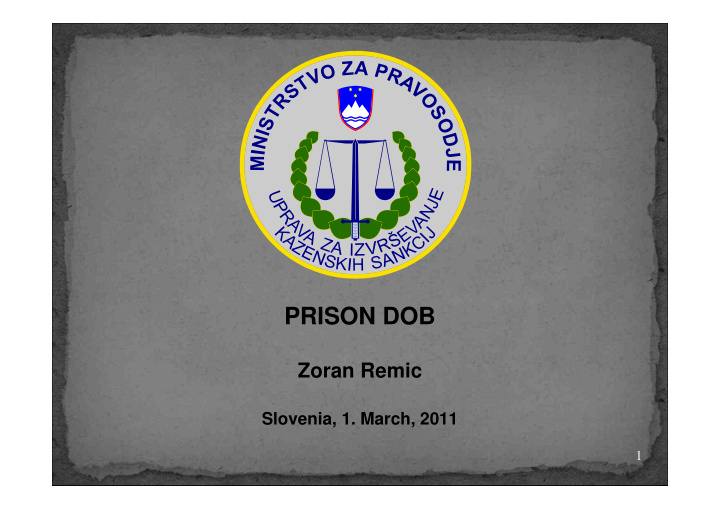



PRISON DOB Zoran Remic Slovenia, 1. March, 2011 1
to ensure that the prisons are safe � for society, for inmates and employees and to provide the possibility of � resocialization to inmates. 2
The central prison in Slovenia, for men with sentence longer then 18months, also for young offenders 18-23 years old, with sentence longer than 5 years. 3
� closed (417/233 inmates), � semi-open and (63 inmates) � open department (17 inmates) They differ according to the level of security and the limitation of freedom of movement. 4
DOB - - CENTRAL CENTRAL PRISON PRISON DOB (MALE) (MALE) Category of inmates: male prisoners 5 Capacity: 233 ; overcrowded
DOB PRISON: SEMI OPEN DEPARTMENT SLOV. VAS DOB PRISON: SEMI OPEN DEPARTMENT SLOV. VAS Category of inmates: male prisoners 6 Capacity: semi open department 63
DOB PRISON: OPEN DEPARTMENT PUŠ Š Č AVA DOB PRISON: OPEN DEPARTMENT PU Č AVA Category of inmates: male prisoners 7 Capacity: 17
DOB PRISON: OPEN DEPARTMENT PUŠ Š Č AVA DOB PRISON: OPEN DEPARTMENT PU Č AVA Kategorije zaprtih: moški obsojenci 8 Kapaciteta: 40
PENAL SANCTIONS ENFORCEMENT ACT � RULES CONCERNING THE ENFORCEMENT � OF PRISON SENTENCES � HOUSE RULES of DOB PRISON 9
The goal of treatment programmes is to preparate inmates for life after release and their reintegration into society. Small groups – Therapeutic community � Suicide prevention programme � � Drug abusers and alcohol treatment programmes Sex offenders treatment programme � Preparation for release and social work � 10
- Interviews with relatives - Phone calls - Writing letters - Home visits
A governor may reward a prisoner for active involvement in the treatment process, for efforts and success at work, and for respecting the prison rules by granting following benefits:
- Longer or unsupervised visits - Unsupervised visits outside the prison - Leave from prison accompanied by an authorised official - Unsupervised leave from prison, except to the place, where the crime was committed - Unsupervised leave from prison (3x max 53 hours) - Part or the entire annual holiday outside the prison - Up to seven days of free annual rest a year
A prisoner must be allowed visits from immediate family members (mother, father, son, daughter, wife, brother, sister), foster parents or guardian at least twice a weekly. With the permission of the prison governor, other persons may also visit. With other persons we (unit’s professional staff) usually do an interview, before they can regularly come unlimited. We usually ask, how do they know each other, where do they come from, if they have been ever sentenced to prison, etc. + we have a chance to know them better and to see, who will come to visit our inmate - they can also lie, and we can get wrong impression about, who they really are; but so far so good ☺ ☺ ☺ ☺
Twice weekly, (un)supervised Wednesdays 9:00-16:45, 1-2 hours Saturdays 9:00.16:45, 1-4 hours - 5 special rooms with bath, bed , 45’ – they can use it during unsupervised visits - Saturdays unsupervised visits outside the prison (only for those, who have max visit length and who already use leaves outside a prison)
- one and only prison in Slovenia, which has visits over night, rare even in Europe - only for inmate’s close relatives - Tuesday-Saturday, 20:00-6:00, every 3 weeks, limited to 5 inmates/night (only 5 rooms with bath, bed, telephon – to call prisonguards); they can order something to eat - + good for maintaining contact with family, keeping inmates happy and motivated - - security problem (transfering drugs and other goods in internal openings)
In the formulation and execution of an individual treatment programme, the responsible centre, the institute responsible for employment, administrative bodies in charge of housing affairs, and public healthcare and education institutions shall be involved, unless this is rejected by the prisoner. Assistance to a prisoner may also be provided by societies, charity organisations, self-help organisations, and other civil society organisations .
At the beginning of prison sentence with permission of inmate, we contact social centres and get information about inmate’s family, relatives, life and every information they can get from person, who he agrees too. They evaluate inmate’s social risk and draw social integration plan Information from centre are important for planning unsupervised leaves from prison, parole planning, and other activities. With centres we also organise visits with children if inmate is divorced, for example. They also help to establish contacts with relatives (contacts they didn’t have). Social workers are leading inmates in solving problems. They are supporting inmates with information they need to reintegrate in community.
The prison shall propose to the responsible centre that it appoint a counsellor to the prisoner, if this is necessary in order to carry out an individual treatment programme. Counsellors shall conduct their work under the supervision of the responsible centre and in cooperation with Administraton staff .
3 months before release – preparation of program of necessary measures of assistance to the prisoner and providing assistance in his integration into society after prison.
In Slovenia we need PROBATION - literally means testing of behaviour or abilities. In a legal sense, an offender on probation is ordered to follow certain conditions set forth by the court, often under the supervision of a probation officer VISITS over night – good praxis, it should be implemented all over the Europe
THANK YOU FOR YOUR ATTENTION ! ☺ ☺ ☺ ☺
Recommend
More recommend